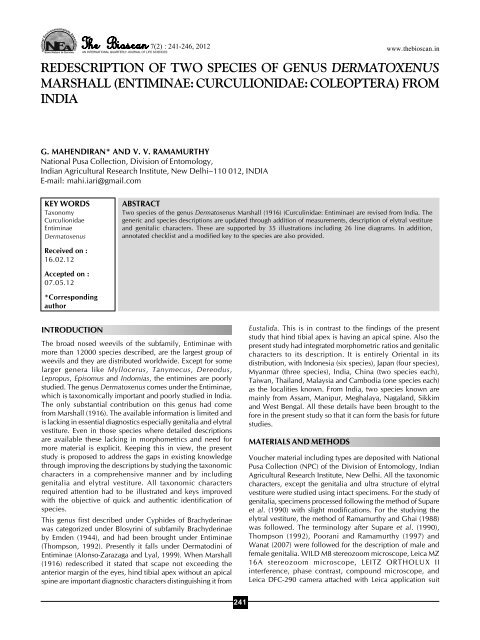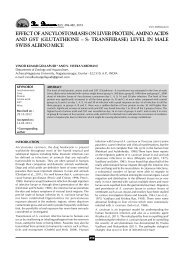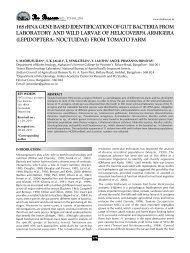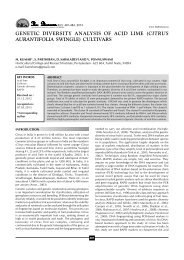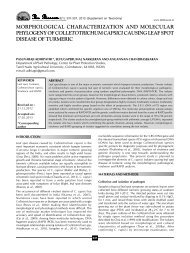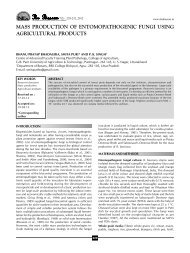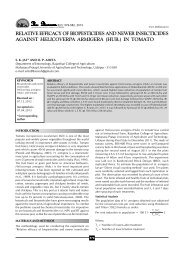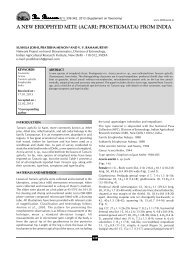fullpaper - THE BIOSCAN
fullpaper - THE BIOSCAN
fullpaper - THE BIOSCAN
You also want an ePaper? Increase the reach of your titles
YUMPU automatically turns print PDFs into web optimized ePapers that Google loves.
NSave Nature to Survive<br />
7(2) : 241-246, 2012 www.thebioscan.in<br />
REDESCRIPTION OF TWO SPECIES OF GENUS DERMATOXENUS<br />
MARSHALL (ENTIMINAE: CURCULIONIDAE: COLEOPTERA) FROM<br />
INDIA<br />
G. MAHENDIRAN* AND V. V. RAMAMURTHY<br />
National Pusa Collection, Division of Entomology,<br />
Indian Agricultural Research Institute, New Delhi–110 012, INDIA<br />
E-mail: mahi.iari@gmail.com<br />
KEY WORDS<br />
Taxonomy<br />
Curculionidae<br />
Entiminae<br />
Dermatoxenus<br />
ABSTRACT<br />
Two species of the genus Dermatoxenus Marshall (1916) (Curculinidae: Entiminae) are revised from India. The<br />
generic and species descriptions are updated through addition of measurements, description of elytral vestiture<br />
and genitalic characters. These are supported by 35 illustrations including 26 line diagrams. In addition,<br />
annotated checklist and a modified key to the species are also provided.<br />
Received on :<br />
16.02.12<br />
Accepted on :<br />
07.05.12<br />
*Corresponding<br />
author<br />
INTRODUCTION<br />
The broad nosed weevils of the subfamily, Entiminae with<br />
more than 12000 species described, are the largest group of<br />
weevils and they are distributed worldwide. Except for some<br />
larger genera like Myllocerus, Tanymecus, Dereodus,<br />
Lepropus, Episomus and Indomias, the entimines are poorly<br />
studied. The genus Dermatoxenus comes under the Entiminae,<br />
which is taxonomically important and poorly studied in India.<br />
The only substantial contribution on this genus had come<br />
from Marshall (1916). The available information is limited and<br />
is lacking in essential diagnostics especially genitalia and elytral<br />
vestiture. Even in those species where detailed descriptions<br />
are available these lacking in morphometrics and need for<br />
more material is explicit. Keeping this in view, the present<br />
study is proposed to address the gaps in existing knowledge<br />
through improving the descriptions by studying the taxonomic<br />
characters in a comprehensive manner and by including<br />
genitalia and elytral vestiture. All taxonomic characters<br />
required attention had to be illustrated and keys improved<br />
with the objective of quick and authentic identification of<br />
species.<br />
This genus first described under Cyphides of Brachyderinae<br />
was categorized under Blosyrini of subfamily Brachyderinae<br />
by Emden (1944), and had been brought under Entiminae<br />
(Thompson, 1992). Presently it falls under Dermatodini of<br />
Entiminae (Alonso-Zarazaga and Lyal, 1999). When Marshall<br />
(1916) redescribed it stated that scape not exceeding the<br />
anterior margin of the eyes, hind tibial apex without an apical<br />
spine are important diagnostic characters distinguishing it from<br />
Eustalida. This is in contrast to the findings of the present<br />
study that hind tibial apex is having an apical spine. Also the<br />
present study had integrated morphometric ratios and genitalic<br />
characters to its description. It is entirely Oriental in its<br />
distribution, with Indonesia (six species), Japan (four species),<br />
Myanmar (three species), India, China (two species each),<br />
Taiwan, Thailand, Malaysia and Cambodia (one species each)<br />
as the localities known. From India, two species known are<br />
mainly from Assam, Manipur, Meghalaya, Nagaland, Sikkim<br />
and West Bengal. All these details have been brought to the<br />
fore in the present study so that it can form the basis for future<br />
studies.<br />
MATERIALS AND METHODS<br />
Voucher material including types are deposited with National<br />
Pusa Collection (NPC) of the Division of Entomology, Indian<br />
Agricultural Research Institute, New Delhi. All the taxonomic<br />
characters, except the genitalia and ultra structure of elytral<br />
vestiture were studied using intact specimens. For the study of<br />
genitalia, specimens processed following the method of Supare<br />
et al. (1990) with slight modifications. For the studying the<br />
elytral vestiture, the method of Ramamurthy and Ghai (1988)<br />
was followed. The terminology after Supare et al. (1990),<br />
Thompson (1992), Poorani and Ramamurthy (1997) and<br />
Wanat (2007) were followed for the description of male and<br />
female genitalia. WILD M8 stereozoom microscope, Leica MZ<br />
16A stereozoom microscope, LEITZ ORTHOLUX II<br />
interference, phase contrast, compound microscope, and<br />
Leica DFC-290 camera attached with Leica application suit<br />
241
G. MAHENDIRAN AND V. V. RAMAMURTHY<br />
ver. 2.8.2 were used in the taxonomic studies. Illustrations<br />
were made using a drawing tube fitted with a camera lucida.<br />
RESULTS AND DISCUSSION<br />
Annotated checklist (Table 1)<br />
Taxonomic studies<br />
Genus Dermatoxenus Marshall, 1916: 50 (Gender: Masculine)<br />
Type species: Lagostomus vermiculatus (Gyllenhal in<br />
Schoenherr, 1833); designated by Marshall, 1916: 51; Alonso-<br />
Zarazaga and Lyal, 1999: 154.<br />
Genus description: Head exserted, more or less constricted<br />
and transversely im-pressed behind the eyes, eyes 1.40x<br />
longer than broad, ovate or almost circular and prominent,<br />
frons with a deep central furrow. Rostrum 1.53 – 1.78x longer<br />
than head, its base 0.99x shorter than frons, 1.15 – 1.21x<br />
dilated at apex, separated from head by a transverse stria or<br />
furrow (Figs. 1, 2), scrobes curving downwards far in front of<br />
eyes, epistome large and bare, acuminate behind and shallowly<br />
emarginate at apex, mandibles slightly prominent, scar small<br />
and indistinct, buccal cavity behind the mandibles almost<br />
square, mentum large but not quite filling cavity, submentum<br />
subtruncate and without any peduncle. Antennae inserted at<br />
or before middle of rostrum, scape clavate, curving forwards<br />
when erect, not or only just reaching anterior margin of eye<br />
(Fig. 3), first and second funicle segments 1.79x longer than<br />
others, club 2x longer than broad, ovate and three segmented.<br />
Prothorax bisinunte at posterior margin, narrower and<br />
subtruncate at anterior margin, anterior margin not sinuate<br />
ventrally. Scutellum present or absent. Elytra separately<br />
rounded at basal margin, with a distinct humeral angle,<br />
subacuminate at apex, margin deeply sinuate above posterior<br />
coxae, and with ten striae. Elytral vestiture of two types,<br />
predominant subrectangular to ovate or subcircular, less<br />
predominant elongate or very elongate, pale yellowish to dark<br />
brown colour. Sternum with epimeron of mesosternum much<br />
smaller than its episternum, metasternum as long as or 1.53x<br />
longer than middle coxae, episternum present but sometimes<br />
very narrow, posterior coxae reaching elytra. Venter with<br />
intercoxal process ogival, second ventrite 1.40x longer than<br />
third or fourth separately, and divided from first by a deep<br />
straight incision. Legs elongate, femora clavate, fore tibiae<br />
curved and with a short internal spine at apex (Fig. 10), tibial<br />
apex of the hind legs enclosed and with or without scales<br />
Table 1: Checklist of the genus Dermatoxenus Marshall of the world<br />
1. binodosus Marshall, 1916: 51 Myanmar<br />
2. caesicollis (Gyllenhal) China, Japan and Taiwan<br />
Lagostomus caesicollis Gyllenhal in Schoenherr, 1833: 619;<br />
Marshall, 1916: 51<br />
Dermatodes caesicollis Gyllenhal in Schoenherr, 1840: 898;<br />
Marshall, 1932: 211<br />
Cneorhinus nodosus Motschulsky, 1860: 21; Marshall, 1916: 51<br />
Dermatodes nodosus Motschulsky, 1866: 179; Marshall, 1916: 51<br />
Catapionus nodosus Touriner, 1876: 153; Marshall, 1916: 51<br />
3. candidus Heller, 1896: 17 Indonesia<br />
4. carinulatus Motschulsky, 1866: 179 Japan<br />
5. chrysochlorus (Ritsema) Indonesia<br />
Dermatodes chrysochlorus Ritsema, 1882: 177; Marshall,<br />
1932: 211<br />
6. clathratus (Roelofs) Japan<br />
Catapionus clathratus Roelofs, 1873: 157; Marshall, 1916: 51<br />
glaucopustulatus Heller see vermiculatus subsp. glaucopustulatus<br />
7. helleri Marshall, 1916: 54 India<br />
7a helleri subsp. simplx Marshall, 1916: 55 India<br />
7b helleri subsp. subrotundus Marshall, 1916: 55 India<br />
8. hians Marshall, 1932: 210 Thailand and Malaysia<br />
9. indicus Marshall, 1916: 53 India<br />
10. interstitialis Motschulsky, 1866: 179 Japan<br />
11. lithocollus Heller, 1915: 216 Indonesia<br />
12. marmoresus Marshall, 1941: 346 Myanmar<br />
13. quadrisignatus Marshall, 1916: 52 Myanmar<br />
14. ritsemai Heller Indonesia<br />
Dermatodes ritsemai Heller, 1915: 214; Marshall, 1916: 51<br />
rosceipes Heller see vermiculatus subsp. rosceipes<br />
15. scutellus Heller, 1915: 212 Cambodia<br />
16. sexnodosus Voss, 1932: 60 China<br />
simplx Marshall see helleri subsp. simplx<br />
subrotundus Marshall see helleri subsp. subrotundus<br />
17. vermiculatus (Gyllenhal) Indonesia<br />
Lagostomus vermiculatus Gyllenhal in Schoenherr, 1833: 619;<br />
Marshall, 1916: 51<br />
Dermatodes vermiculatus Gyllenhal in Schoenherr, 1840: 898;<br />
Marshall, 1932: 211<br />
17a vermiculatus subsp. glaucopustulatus Heller, 1915: 209 Indonesia<br />
17b vermiculatus subsp. rosceipes Heller, 1915: 215 Indonesia<br />
242
REDESCRIPTION OF GENUS DERMATOXENUS MARSHALL<br />
Figure 1 to18: Dermatoxenus. Head, dorsal view: 1. indicus, 2. helleri, lateral view: 3. indicus, 4. helleri; Prothorax, dorsal view: 5. indicus,<br />
6. helleri; 7. Antenna of Dermatoxenus indicus; Elytron, dorsal view: 8. indicus, 9. helleri; 10. Fore tibiae of Dermatoxenus; Hind tibial apex:<br />
11. indicus, 12. helleri; 13, 14. Tarsi and claw of Dermatoxenus; Elytral vestiture: 15, 16. indicus, 17, 18. helleri<br />
243
G. MAHENDIRAN AND V. V. RAMAMURTHY<br />
Figure 19 to 35: Dermatoxenus. 19 – 23, 27 – 29. Male genitalia, median lobe, dorsal, ventral and lateral views, tegmen and spiculum gastrale<br />
of Dermatoxenus indicus; 24 – 26, 30 – 31. Female genitalia, genital chamber, spermatheca and spiculum ventrale of Dermatoxenus helleri;<br />
Dorsal and lateral view habitus: 32, 33. indicus, 34, 35. helleri<br />
244
REDESCRIPTION OF GENUS DERMATOXENUS MARSHALL<br />
internally (Figs. 11, 12), tarsi with third segment very broadly<br />
lobate, fourth elongate, claws connate at base (Figs. 13, 14).<br />
Female genitalia having spermatheca with proximal arm 1.37x<br />
longer than distal arm, ramus and nodulus projecting out,<br />
cornu with rounded apex, spiculum ventrale elongate with<br />
clubbed apex. Male genitalia with aedeagus 1.42x longer than<br />
apophyses, median lobe sclerotized, tegmen with acuminate<br />
parameres, and spiculum gastrale with apex clubbed.<br />
Key to species (modified after Marshall, 1916)<br />
1. Scutellum distinct, elytra with larger rounded tubercle at<br />
top of te declivity on third interval<br />
………………..........................................…………binodosus<br />
- Scutellum invisible, elytra without tubercles (Figs. 32-<br />
35)…………………...…….............................................…....2<br />
2. Hind tibial apex densely squamose inside (Fig. 11),<br />
shoulders of elytra prominent, prothorax with a central<br />
furrow (Fig. 5); fore coxas in middle of the<br />
prosternum…..............................................................……..3<br />
- Hind tibial apex bare, shoulders of elytra not pro-minent<br />
(Fig. 12), prothorax without a central furrow (Fig. 6), fore<br />
coxae nearer anterior margin of the prosternum............<br />
................................................................................... helleri<br />
3. Eye situated midway between anterior margin of head and<br />
posterior constriction. Elytron with two large bare rugose<br />
black patches on intervals fourth and<br />
fifth................................................................quadrisignatus<br />
- Eye much nearer to anterior margin of head, elytra without<br />
bare patches, prothorax as long as broad (Fig. 5), aedeagus<br />
1.42x as long as apophyses, 3.4x as its median lobe,<br />
median lobe sclerotized and slightly curved (Figs. 19, 20,<br />
21, 27)…………..................................................…...indicus<br />
Species description<br />
1. Dermatoxenus indicus Marshall<br />
(Figs. 1, 3, 5, 7, 8, 11, 15, 15, 16, 19, 20, 21, 22, 23, 27, 28,<br />
29, 32 and 33)<br />
Dermatoxenus indicus Marshall, 1916: 53 [BMNH].<br />
Description<br />
General colour black, with dense brown vestiture, turning to<br />
pale fawn, greyish or whitish on laterally, underparts and at<br />
apex, upper surface of elytra usually variegated with similar<br />
pale markings, especially across top of declivity (Figs. 32, 33).<br />
Head evidently constricted and transversely impressed at base,<br />
eyes placed close to anterior margin, frons with a deep central<br />
furrow, 0.53x as long and 1.16x as broad as rostrum, 0.39x as<br />
long and 0.7x as broad as prothorax. Rostrum 1.48x as long<br />
as the breadth at base of rostrum and 1.05x as long as breadth<br />
at base of head separated from head by a narrow transverse<br />
furrow, sides parallel at base, genae sharply angulated, upper<br />
surface shallowly impressed and with a deep central furrow<br />
(Figs. 1, 3). Antennae with dense pale vestiture, scape not<br />
reaching eye, second segment longest, 1.31x, 1.89x, 2.13x,<br />
1.89x as long as first, third, fourth, fifth and sixth and seventh,<br />
respectively; in terms of breadth, seventh segment broadest of<br />
all, 1.2x as broad as first to sixth segment. Club 2.24x as long<br />
as second, and 4.23x as long and 1.59x as broad as seventh<br />
segment of funicle (Fig. 7).<br />
Prothorax 1.38x as long as and 1.66x as broad as rostrum, as<br />
broad as long, widest at base and gradually narrowing to apex,<br />
base 1.36x as broad as apex, transversely rugose, with a distinct<br />
central furrow varying in length and depth, and a similarly<br />
variable furrow on each side of it (Fig. 5). Legs with dense<br />
vestiture, tarsi broad, hind tibial apex densely squamose<br />
internally (Fig. 11).<br />
Elytra 3.09x as long as rostrum, 2.25x as long and 1.58x as<br />
broad as prothorax, 0.86x as that of its breadth at base,<br />
separately rounded at base, shoulders broad and prominent,<br />
sides subparallel, striae deep with large punctations which<br />
partially concealed by the very dense vestiture, intervals broad<br />
and convex, third interval broader than fourth, setae very short,<br />
thick, sparse and depressed (Figs. 8, 32, 33). Elytral vestiture<br />
of two types, predominant flat, subrectangular to ovate, with<br />
granulated surface, and brown to dark brown (Fig. 15), less<br />
predominant elongate, spindle shaped, granulated at basal<br />
half, opaque and brown (Fig. 16).<br />
Venter with first ventrite longest, 1.94x, 2.82x and 1.3x as<br />
long as second, third and fourth and fifth, respectively; in term<br />
of breadth, first the broadest, 1.2x, 1.49x, 1.91x and 2.35x as<br />
broad as second, third, fourth and fifth, respectively.<br />
Male genitalia with aedeagus 1.42x as long as apophyses,<br />
3.4x as its median lobe, 1.85x as long as spiculum gastrale,<br />
2.05x as long as tegmen, median lobe sclerotized, slightly<br />
curved in lateral view, apex bluntly pointed, 2.12x as long as<br />
manubrium, its base 1.08x as broad as middle and 1.25x as<br />
broad as the breadth just before apex, breadth at middle 1.17x<br />
as broad as the breadth just before apex, breadth from sides<br />
2.75x as broad as that of apophyses. Apophyses as broad as<br />
manubrium (Fig. 19, 20, 21, 27). Tegmen 2.03x as long as<br />
manubrium, parameres acuminate, manubrium uniformly<br />
thick, bent at middle, apex bluntly pointed (Fig. 22, 28).<br />
Spiculum gastrale 0.77x as long as apophyses and 1.11x as<br />
long as tegmen, slightly curved at base, uniformly thick with<br />
apex clubbed, 1.2x as broad as apophyses and 1.2x as broad<br />
as that of manubrium (Fig. 23, 29).<br />
Length: 10.44 mm.; breadth: 3.79 mm.<br />
Specimens examined: Assam: Assam, date unknown, Zool.<br />
Mus. Berlin; West Bengal: Lebong, 5000 ft., vi.1909, Coll.<br />
H.M.L; x.1908, Coll. H.M.L.<br />
Distribution: INDIA: Assam; Nagaland: Naga Hills; West<br />
Bengal: Lebong, Mungpu.<br />
2. Dermatoxenus helleri Marshall (Fig. 2, 4, 6, 12, 17, 18, 24,<br />
25, 26, 30, 31, 34, 35)<br />
Dermatoxenus helleri Marshall, 1916: 55 [BMNH , ].<br />
Description<br />
General colour black, with uniform pale green, grey or sandy<br />
vestiture (Figs. 34, 35). Head with basal constriction and<br />
impression shallow, 0.66x as long and 1.48x as broad as<br />
rostrum, 0.51x as long and 0.75x as broad as prothorax, eyes<br />
a little nearer to front margin than to constriction, frons with a<br />
narrow furrow. Rostrum 1.43x as long as the breadth at base<br />
of rostrum and 0.97x as long as the breadth at base of head,<br />
separated from head by a fine furrow on each side, furrows<br />
usually separated on disk, but sometimes meeting to form a<br />
slight angle, genae broadly but bluntly angulated, upper surface<br />
with a broad, shallow, longitudinal impression (Figs. 2, 4).<br />
Antennae comparatively slender, with pale green or grey<br />
245
G. MAHENDIRAN AND V. V. RAMAMURTHY<br />
vestiture, scape just reaching the eye, funicle with first segment<br />
a little shorter than second, segments third to seventh subequal<br />
and not transverse, club black and with first segment longer<br />
than second.<br />
Prothorax 1.31x as long as and 1.97x as broad as rostrum,<br />
1.06x broader than long, broadest at base, base 1.41x as<br />
broad as apex, sides subparallel from base to beyond middle,<br />
then rather sharply narrowed in , less sharply in upper<br />
surface quite smooth, with a faint central carina and often a<br />
shallow impression on each side of it, and with scattered,<br />
small, black punctations (Fig. 16). Legs with dense green<br />
vestiture and small black spots, hind tibial apex not squamose<br />
inside, second segment of hind tarsi not transverse.<br />
Elytra 3.51x as long as rostrum, 2.69x as long and 1.63x as<br />
broad as prothorax, 2.49x as that of its breadth at base, jointly<br />
sinuate in middle of base, shoulders obtuse and not very<br />
prominent, sides more strongly rounded, broadest far behind<br />
middle, striae broad and with large deep punctations, filled in<br />
with vestiture that striae appear narrow and punctations faint<br />
and shallow, first and second and third and fourth striae<br />
converging at base, intervals convex, with small, dark,<br />
punctations containing minute setae, alternate ones more<br />
raised, third interval broadly interrupted twice behind middle,<br />
fifth interrupted at middle, and seventh on declivity, these<br />
interruptions variable, striae first and second contain rows of<br />
distinct shiny granulations at their basal half (Figs. 9, 34, 35).<br />
Elytral vestiture of two types, predominant flat, subcircular,<br />
granulated and pale yellow or white with brown tinges (Fig.<br />
17), less predominant very elongate, hair like, with short<br />
pedicel and light brown (Fig. 18).<br />
Venter with first ventrite longest, 1.88x, 3x and 1.2x as long as<br />
second, third and fourth and fifth, respectively; in term of<br />
breadth, first the broadest, 1.14x, 1.45x, 1.79x and 2.28x as<br />
broad as second, third, fourth and fifth, respectively.<br />
Female genitalia having spermatheca with proximal arm 1.37x<br />
as long as distal arm, nodulus and ramus projecting out, tubular<br />
with pointed apex, ramus small, its apex blunt, cornu slightly<br />
bent, apex rounded, projecting close towards proximal arm<br />
(Figs. 24, 25, 30). Spiculum ventrale with shaft elongate, apex<br />
clubbed, 1.72x as long as basal plate, basal plate 1.39x as<br />
broad as long, apex bluntly pointed, with numerous hairs<br />
(Figs. 26, 31).<br />
Taxonomic note: Marshall (1916) states that third interval<br />
broadly interrupted twice behind middle, fifth interrupted at<br />
middle, and seventh on declivity, and than these interruptions<br />
variable. But examination of the specimen, which is compared<br />
with type, shows that there is only one interruption at third<br />
interval about middle, others absent.<br />
Length: 14.11 mm.; breadth: 4.88 mm.<br />
Specimen examined: Assam: date unknown, Zool. Mus. Berlin.<br />
Distribution: INDIA: Assam; Manipur: Ukhrul (6500 ft.);<br />
Meghalaya: Shillong, Khasi hills, Chirapunji; Sikkim: Rangbong<br />
valley; West Bengal: Gopaldhara.<br />
REFERENCES<br />
Alonso-Zarazaga, M.A. and Lyal. C.H.C. 1999. A world catalogue of<br />
families and genera of Curculionoidea (Insecta: Coleoptera) (excepting<br />
Scolytidae and Platypodidae). Entomopraxis, S.C.P., Spain. p. 315.<br />
Emden, F.I. van. 1944. A key to the genera of Brachyderinae of the<br />
world. Annals and Magazine of Natural History. (11) 11: 503-532.<br />
Heller, K. M. 1915. Ent. Mitt. 4: 209- 216.<br />
Heller, K.M. 1896. Neue Kafer von Celebes gesammelt von den<br />
Herren Dr. P. Sarasin und Dr. F. Sarasin. Abhandlungen und Berichte<br />
des koniglichen Zoologischen und Anthropologisch-Etnographischen<br />
Museums zu Dresden, (1896/97). 6(3): 1-26.<br />
Marshall, G.A.K. 1916. Coleoptera. Rhynchophora: Curculionidae.<br />
In The Fauna of British India including Ceylon and Burma, Shiply,<br />
A.E. (Ed.). Taylor and Francis, London, p.367.<br />
Marshall, G.A.K. 1932. New Oriental Curculionidae (Coleoptera).<br />
Stylops. 1(10): 209-216.<br />
Marshall, G.A.K. 1941. On Curculionidae (Coleoptera) from Burma.<br />
Annals and Magazine of Natural History, Ser. II. 8: 345-379.<br />
Motschulsky, V. de. 1860. Études entomologiques, 9. Helsingfors, p.41.<br />
Motschulsky, V. de. 1866. Catalogue des insectes reçus du Japon.<br />
Bulletin de la Société Impériale des Naturalistes de Moscou. 39(1):<br />
163-200.<br />
Poorani, J. and Ramamurthy, V. V. 1997. Weevils of the genus<br />
Lepropus Schoenherr from the Oriental region (Coleoptera:<br />
Curculionidae: Entiminae). Oriental Insects. 31: 1-81.<br />
Ramamurthy, V.V and Ghai, S. 1988. A study on the genus Myllocerus<br />
(Coleoptera: Curculionidae). Oriental Insects. 22: 377-500.<br />
Ritsema, C. 1882. Notes from the Leyden Museum. 4: 177.<br />
Roelofs, W. 1873. Curculionides recueillis au Japon par M. G. Lewis.<br />
Premiere partie. Annales de la Societe Entomologique de Belgique.<br />
16: 154-193.<br />
Schoenherr, C.J. 1833. Genera et species curculionidum, cum<br />
synonymia hujus familiae. Species novae aut hactenus minus cognitae,<br />
descriptionibus a Dom. Leonardo Gyllenhal. C.H. Boheman, et<br />
entomologis aliis illustratae. 1(2): 383-681.<br />
Schoenherr, C. J. 1840. Genera et species curculionidum, cum<br />
synonymia hujus familiae. Species novae aut hactenus minus cognitae,<br />
descriptionibus a Dom. Leonardo Gyllenhal. C.H. Boheman, et<br />
entomologis aliis illustratae. 5(2): 465-970.<br />
Supare, N. R., Ghai, S. and Ramamurthy, V. V. 1990. A revision of<br />
Tanymecus from India and adjacent countries (Coleoptera:<br />
Curculionidae). Oriental Insects. 24: 1-126.<br />
Thompson, R.T. 1992. Observations on the morphology and<br />
classification of weevils (Coleopteran: Curculionidae) with a key to<br />
major groups. J.Natural History. 26: 835-891.<br />
Touriner, H. 1876. Etude des especes europeennes et<br />
circumeuropeenes du genre Cneorhinus Schoenh. De la tribu des<br />
Brachyderides, Curculionides Adelognathes cyclophthalmes. Annales<br />
de la Societe Entomologique de Belgique. 19: 125-163.<br />
Voss, E. 1932. Weitere Cuculioniden aus Yunnan und Szetschwan<br />
der Summlung Hauser (Coleoptera: Curculionidae). Wiener<br />
Entomologische Zeitung. 49(2): 57-76.<br />
Wanat, M. 2007. Alignment and homology of male terminalia in<br />
Curculionoidea and other Coleoptera. Invertebrate Systematics. 21:<br />
147-171.<br />
246


